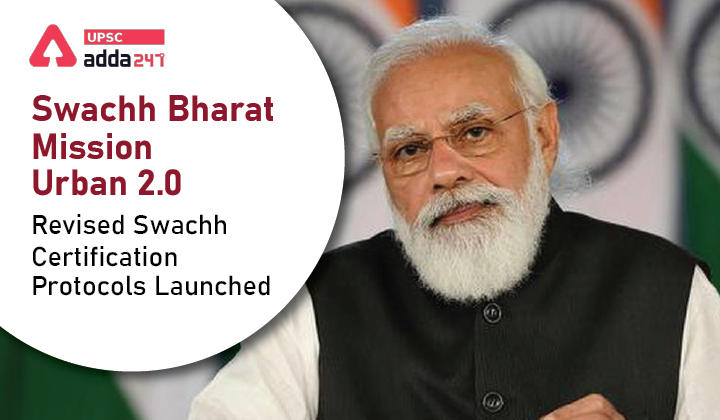Table of Contents
Swachh Certification Protocols: Relevance
- GS 2: Government policies and interventions for development in various sectors and issues arising out of their design and implementation.
Swachh Bharat Mission Urban 2.0: Context
- Recently, Ministry of Housing & Urban Affairs has launched the Revised Swachh Certification Protocols for ODF, ODF+, ODF++, and Water+ certifications under Swachh Bharat Mission-Urban 2.0.
https://www.adda247.com/upsc-exam/swachh-bharat-mission-urban-2-0-hindi/
Swachh Certification Protocols : Key points
The revamped revised protocol is aligned with SBM-2.0 objectives and is designed to ensure:
- No untreated used water or faecal sludge is discharged into the environment and all used water (including sewerage and septage, grey water and black water) is safely contained, transported, and treated in all cities with less than 1 lakh population.
- To sustain open defecation free status in all statutory towns.
Swachh Certification Protocols
- Swachh Certification Protocols emphasises on the need for certification processes to constantly evolve to become more comprehensive.
- The Revised Swachh Certification Protocols is more functionality-oriented and has been simplified for officials and citizens to understand it better.
- The purpose of the protocol is not only to improve rankings of cities but to motivate cities to achieve the spirit of the Mission.
https://www.adda247.com/upsc-exam/swachh-bharat-mission-urban-2-0-hindi/
Key interventions against each certification
- ODF – Robust monitoring mechanism ensured by increasing the number of survey sample size and location types.
- ODF+ – Focus on functionality of CT/PT and innovative O&M business model for their sustainability in long run.
- ODF++ – Emphasis on mechanized cleaning of septic tanks and sewers. Safe collection & treatment of used water as well as safe management of faecal sludge.
- Water+ – The focus is on collection, transportation, treatment, and reuse of both used water and faecal sludge to prevent environmental pollution.
Objective of SBM 2.0
- All statutory towns will become at least ODF+; and all cities with <1 lakh population ODF++.
- Systems and processes will be in place so that all waste water is safely treated and optimally reused and no untreated wastewater pollutes water bodies.
- Regarding the Solid Waste Management, it is expected that all cities will achieve at least 3-star Garbage Free certification under SBM-U 2.0.
SBM Achievement
- SBM has achieved sustainable sanitation in over 3,300 cities and over 950 cities have been certified ODF+ and ODF++ respectively.
- Also, 9 cities have been certified Water+, which entails treatment of wastewater and its optimum reuse.
- The thrust on scientific waste management is evident with waste processing in India going up by over four times from 18% in 2014 to 70% today.
- This has been aided through 100% door-to-door waste collection in 97% wards and source segregation of waste being practised by citizens in letter and spirit across 85% wards.
- The active participation of 20 crore citizens (comprising over 50% of India’s urban population) in the program has successfully transformed the Mission into a people’s movement, a true Jan Andolan.
Read current affairs for UPSC





 TSPSC Group 1 Question Paper 2024, Downl...
TSPSC Group 1 Question Paper 2024, Downl...
 TSPSC Group 1 Answer key 2024 Out, Downl...
TSPSC Group 1 Answer key 2024 Out, Downl...
 UPSC Prelims 2024 Question Paper, Downlo...
UPSC Prelims 2024 Question Paper, Downlo...




